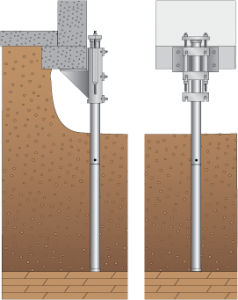Sinking Foundation Solutions
Now that some of the snow has melted, you may have noticed some changes with your foundation. Maybe your doors are not closing properly, maybe your floors are beginning to slope, or maybe you’ve noticed that your foundation is not exactly level. All of these are signs of a sinking foundation–something that can be exacerbated by the winter thaw and freeze.
 What causes a sinking foundation?
What causes a sinking foundation?
The main cause of a sinking foundation is problems with soil upon construction. If your home was not built on properly compacted soil, it will begin to have problems over time. Likewise, if the soil in your area is an expansive soil — like clay — then foundation problems are bound to be an issue for most all homeowners. Over time, the soil will shift and cause your home to shift as well. This can result in cracks in the foundation walls and slab, slanted floors, and a leaning house. Obviously, these are not issues that you can ignore. Foundation problems, especially those involving a sinking foundation, should be resolved as soon as possible to prevent further damage or safety problems in your home.
Repair Options for a Sinking Foundation
One of the best options for a settling or sinking foundation are steel push piers. Steel push piers, an Earth Contact Products (ECP) device, are an underpinning product for your foundation. These piers are driven into deep, stable soil which can support your foundation better than the shifting soil at the top which has caused foundation problems. After they are secured, the hydraulic lifting system will raise your foundation back to where it was previously.
Another option for slab foundations are helical piers. Helical piers, another ECP product, are screw anchors that work to support your home when your foundation is failing. They come in a variety of lengths and widths to fit every foundation repair situation. Unlike steel push piers, which are merely driven into the soil, helical piers are screwed into the ground to provide extra stability.
Steps for Installation
Rapid Foundation Repair uses a set system of installation for steel push piers to ensure quality and safety. First the site is surveyed for proper pier placement. Next, excavation and prep of the foundation is commenced. This is a perimeter excavation, and the space required at the foundation is usually about three square feet. After this, the steel resistance pier bracket is secured to the footing using anchor bolts, and the steel pier pipe is advanced into the soil. The piers may be installed from outside or inside the structure. At this point, each pier is load tested to guarantee safety. Lastly, the piers are prepped for restoration and the foundation is then restored to its original elevation (or recommended elevation of engineer). The crew will then replace the soil and clean up the work site. For more information on the installation process, please visit our website.
Helical piers installation is similar, but it does cause less disturbance to the land and is screwed into concrete for more stability (rather than just driven into the soil). Helical piers can also be installed in all weather and are relatively easy to install. This is a popular option for lightweight repairs, as it cannot support extremely heavy repairs.
If you have a sinking foundation, it may be time to call the professionals at Rapid Foundation Repair. We have the experience and tools to make your foundation repair project economical, safe, and quality. Contact us today for a quote!

 What causes a sinking foundation?
What causes a sinking foundation?